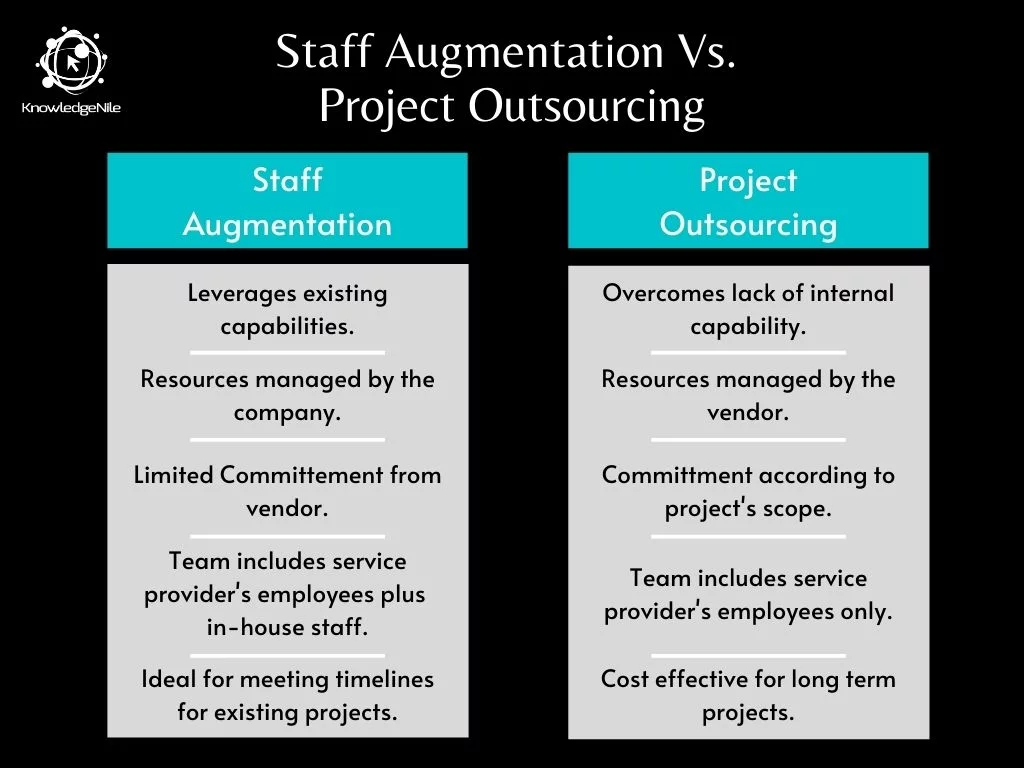With the dependency on technology in the world on the rise, being updated with the newest technology trends isn't an option.
The success of any project depends on multiple factors such as:
- How soon it can be delivered, or
- Whether it can be delivered on time,
- Within budget
- According to the requirements of the client
When a project's requirements in terms of timelines or specialty go beyond the scope of the in-house personnel available, companies turn to technical staffing services. The two common solutions in such conditions are staff augmentation and project outsourcing.
But which one to opt for or whether a hybrid solution should be considered depends on the project's requirements. Let's first try and understand these terms and then see a comparison between the two.
Staff augmentation services allow teams to have flexibility in their teams according to the ongoing projects' requirements. It helps you to hire and manage your augmented teams directly.
Here, you get to choose the candidates that are fit for the roles you are hiring. You can extend or reduce your teams as and when required.
Staff augmentation lets you add skilled staff to your in-house development teams. These resources could either be added on a short-term or long-term basis.
As the name indicates, here, companies outsource the entire task that needs to be done. This could include entire projects or some parts of the ongoing projects that need to be done.
Here, organizations end up paying only for the services required. They do not need to invest in the infrastructure needed if the personnel is hired full-time.
In project outsourcing, the agency has to hire, train and manage the team to get the work done. Organizations need not pay attention to the infrastructure or the tools required for the development tasks or the services they need.
Now that we have seen what the two terms mean, let us take a look at the comparison of both on various factors as below:
In both the models, recruitment of skilled employees is the responsibility of the external agency. The organization does not need to worry about the recruitment and onboarding of the employees.
Outsourcing a project means that the organization does not have to worry about the people's hiring cost to manage the project either. The infrastructure costs such as office space, systems, and tools required are also saved.
This is not the case with staff augmentation. Here, the organization would need the managers to overlook the project planning and progress. The company would also need the infrastructure required for the augmented staff members.
Office space, systems, tools required are just some of the things as are necessary for the organization to take care of.
In the case of both the models, the outsourced agencies are responsible for the recruitment of trained and skilled professionals.
Once an organization has outsourced a certain project to an external agency, they do not have to worry about the technology being used to develop or get the employees accustomed to the organization's culture.
With staff augmentation, the new employees need an induction to be on board with the company culture and work methodologies. They might be comparatively unfamiliar with the development methodologies the company uses.
Training the employee to suit your requirements becomes an overhead with staff augmentation.
Project management implies managing the way the project proceeds.
With staff augmentation, even if the skilled staff is recruited from an IT staffing agency, they would be required to hire a project manager. The manager would be responsible for the progress of the project and overlooking the functioning of the team. The employees would need to get used to the manager and vice versa. However, it is easier to manage the projects and overlook the project progress in this model.
In project outsourcing, the outsourcing organization needs not to worry about managing the project or having a manager. The outsourced agency has a set team to manage the teams with experienced managers. These managers have the experience and expertise required to handle their team. In addition, they are used to the team they work with, knowing the capabilities of the employees.
Here, the agencies have teams and managers who have already figured out the most efficient way to manage the project. Since they might have worked on similar projects in the past, they probably have a better hang of how to go about a certain project in order to reduce the time required to complete the project on time.
Also Read:10 Key Steps for Business Intelligence Implementation
Project outsourcing requires that the requirements of the project be set and agreed upon before the start of the project itself. Minor changes or additions might not affect much, but anything significant could lead to a change in the terms or costing and timelines of the project.
With staff augmentation, any change in requirements would mean directing the team in a different direction. Explaining the changed requirements and getting it done has no effect on the contract with the IT staffing agency.
The process becomes more straightforward and easier to manage as compared to project outsourcing.
Where and with whom you work makes a difference in your productivity. It is more comfortable to work in a stable known environment with known people around you.
With project outsourcing, the agency's employees are used to the environment they work in. Even if the projects differ, they work with the same people. It leads to more meaningful friendships and understanding between the teammates. They are also used to the tools they have to work with, thus reducing the time required to get the hang of the work environment.
Such a healthy atmosphere to work in leads to better productivity and overall work culture.
With staff augmentation, working in a different atmosphere with different people needs to get used to in the beginning.
Each company might use different tools and might have different work culture and environment. Getting the hang of all these factors could lead to low productivity in the starting few days.
The employees might not be as invested in the project or the team as they know that they would have to work on a different project with another organization sometime in the future. This could be a de-motivator and could lead to the employees not giving their 100%.
The relationship between the vendor and the organization does impact the success of the business.
With project outsourcing, there is more direct involvement of both the parties in the project. A close partnership is required to understand the requirements of the projects better. It is also necessary to understand the organization's limitations and the agency both for the arrangement to work out.
There is more involvement and communication between the two parties throughout the project. Both are equally involved with the end result and the success of the project.
With staff augmentation, however, once the personnel is on boarded with the organization, the IT staffing agency need not pay attention to the development of the project. There is a lesser need for communication between the organization and the vendor once the project starts.
The only relation between the two parties is of the amount of personnel required and the duration for which the organization needs them.
Such partnerships often end with the project. The agency delivering the required staff is not quite so invested in the project's success or failure.
There are times when adopting either one of the above models might not cut the requirements. Even after trying both the models individually, it might not be enough to complete the projects on time. In such a case, the organization can consider the option of a hybrid approach. Here, the company would be able to alternate between staff augmentation and project outsourcing according to the requirements or progress of the project. Or they could have both working at different stages in the development process.
Key Takeaways
The two methodologies do seem lucrative, but they do not reduce the importance of in-house employees. They have their duties and responsibilities.
Both models have their pros and cons. One model might work for some organizations but might not work for another. It depends on the requirements and available resources for the organization and also the particular project.
You May Also Like to Read:
Emerging Trends in IT Vendor Management






